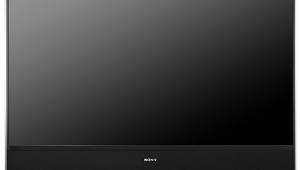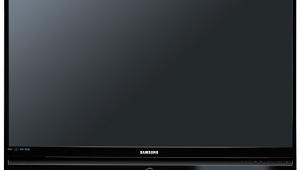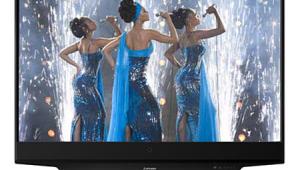V, Inc. Vizio RP56 DLP rear-projection TV Page 2
Considering its low price, the RP56 delivered an amazingly good picture. There were problems, of course, some inherent to DLP technology and some unique to the RP56. Let's start with black level.
Current DLP products have a hard time producing a true black because the lamp is always on and the tiny micromirrors can only angle the light away from the screen, not suppress it entirely. The RP56 is no exception; a full black-field test pattern clearly produced a screen that was dark gray, not black.
A high black level causes a number of picture problems, all evident on the RP56. Dark scenes could look washed out, and shadow details sometimes merged into an undifferentiated blob. The set's overall contrast ratio was also reduced. V, Inc. claims a 1500:1 contrast ratio for the RP56, which might be possible if you adjust the Brightness to 0% and the Contrast to 100%. With the picture correctly adjusted, however, TJN and I measured ratios in the 500:1 to 600:1 range—acceptable, but nothing to write home about (see sidebar, "Calibration and Comment").
All that said, in my experience, only a few CRT-based RPTVs have exhibited well-controlled black levels, and then only when perfectly calibrated. Some sets can produce a deep black with a full-field test pattern, but with actual program material the level changes, or "pumps" up and down. Many CRT sets also suffer from internal reflections, which manifest as streaks or smears of light on bright objects, such as white credit crawls on a black background. The RP56's black level might have been relatively high, but it remained rock-solid consistent at that level regardless of picture content.
 Moving to the other end of the spectrum, the RP56's whites were extended and never "blew out," even with the Contrast set to 100%. And boy,oh, boy, could this baby generate light. We measured 117 footlamberts at 100% Contrast—enough to cause a moth to spontaneously burst into flame at ten paces. Heck, the RP56 produced an overly bright 52.6fL even with the Contrast set to 0%. Because the 0% setting further reduced the contrast ratio, we ended up with Contrast set to 30%, which resulted in a peak light output of more than 75fL. One thing's sure: the RP56 is well suited for viewing in well-lit spaces.
Moving to the other end of the spectrum, the RP56's whites were extended and never "blew out," even with the Contrast set to 100%. And boy,oh, boy, could this baby generate light. We measured 117 footlamberts at 100% Contrast—enough to cause a moth to spontaneously burst into flame at ten paces. Heck, the RP56 produced an overly bright 52.6fL even with the Contrast set to 0%. Because the 0% setting further reduced the contrast ratio, we ended up with Contrast set to 30%, which resulted in a peak light output of more than 75fL. One thing's sure: the RP56 is well suited for viewing in well-lit spaces.
Color My World
Many DLP and LCD displays suffer from overhyped greens and yellows. At times, green foliage and grass can seem almost fluorescent, which looks very unnatural. The RP56 did exhibit this effect to some extent, especially with HD program material or when using the DVI input. The latter was a real drag—the RP56's DVI input lacks access to the Color and Tint controls.
Fortunately, the component inputs do offer Color and Tint controls. Tweaking the Color down a notch, from the default 50% to 45%, and dropping the Tint two clicks, to 2R, greatly ameliorated the overhyped greens, resulting in a more natural look. In fact, the Vizio's color reproduction can best be described as "vivid." The opening sequence of Austin Powers: International Man of Mystery was almost painfully psychedelic, as it should be. Yeah, baby, yeah!
One thing you won't have to do is hire an ISF-certified tech to come out and calibrate your RP56's color temperature. There are no RGB drive controls in the user menu, and according to V, Inc. there's no service menu at all—what you see is what you get. Fortunately, the Warm color-temperature setting produced a fairly flat gray-scale curve in a slightly blue temperature range centered around 7000K (instead of the correct D6500) when using the component input, and around 7600K through the DVI input—disappointing but not disastrous.
Single-chip DLP displays are infamous for producing picture artifacts called "rainbows." In over two months of daily viewing, I saw nothing on the RP56 that I'd call a "rainbow." Perhaps I can't see them: TJN points out that some people seem to be immune. For once, I guess I'm one of the lucky ones. If you're concerned about this, be sure to spend some quality time viewing the set before laying your money down.
The RP56's resolution was good. Using a Leader HD signal generator into the component input, we measured 900 lines per picture height at 1920x1080 (1080i) and 650 lines at 1280x720 (720p). (Perfect performance would have yielded 1080 and 720 lines, respectively.) We didn't have access to an HD signal generator with a DVI output, but we did have a DVI-equipped Bravo D1 on hand. With the player set to 720p output, resolution test patterns from the Video Essentials and Avia test DVDs clearly showed that, with a DVD source, the RP56's DVI input was sharper than its component input.
To summarize, you can get better color from the RP56 using a component input, and better resolution using the DVI input. You just can't have both. At this early stage of the DVI game, I much prefer the component input. I suspect this will change in the near future as the manufacturers get their DVI act together.
Aspect Ratios
Like all widescreen sets, the RP56 has several modes that attempt to expand a "full-frame" (4:3) picture to fill the 16:9 screen. None of these are successful. The Panoramic mode leaves the center of the image mostly intact, but radically stretches the last few inches of the sides to fill the screen. This results in a totally unwatchable fisheye-lens effect. The Zoom mode simply blows up the image, cropping the top and bottom and losing way too much information in the process.
I don't consider the lack of an effective expansion mode to be a big deal; you can enjoy properly framed 4:3 TV pictures in the center of the screen with black bars on either side. And since DLP is not susceptible to image burn-in, you don't have to put up with aggravating gray bars (as you do with many CRT sets), or worry that you're ruining your expensive new widescreen TV simply by watching the nightly news.
Conclusion
V, Inc.'s Vizio RP56 represents an excellent value. Its high black level and lack of a service menu will probably knock it off most videophiles' short lists, but that's okay. If all you do is watch movies on DVD in a dark room, no reasonably priced DLP, LCD, or plasma display is going to scratch your itch. If you're on a budget, go for something like the Hitachi 51SWX20B HD-ready CRT rear projector TJN raved about in the November 2002 issue. Get it calibrated by an ISF pro and you're in business.
On the other hand, the Vizio RP56 is perfect for anyone who wants a big, multipurpose video display that won't break the bank—or your back when you move it into position. Sports fans and nonvideophile family members will also like the fact that the RP56 can deliver the goods in a lighted room. It can also do double duty as a giant computer monitor. (Try Microsoft's Flight Simulator for an immersive experience.) The kids will love playing Nintendo through this set, and you can let 'em, cause they can't burn it in.
For $3299 (and the price I saw that day in Costco was hundreds lower), you get perfect convergence and better geometry than all but the most expensive CRT sets. You get a detailed, quiet, and stable picture whether your tastes run to regular TV fare, DVD movies, or HD broadcasts. What's not to like?
Just don't forget to grind the coffee beans on your way out of Costco.


























































